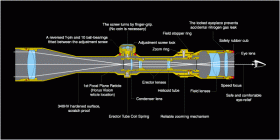I have three Elite 4200s,one 6-24x42 and two 6-24x50). When I did my box tests on these, I was happy to see that all three scopes were very repeatable. However, I was puzzled to find that 10 MOA of clicks didn't get 10 MOA of movement -- in fact, on all three scopes I found that 10 MOA of clicks yielded 11 MOA of movement,11.5' or 10.98 MOA, to be precise).
It's a real pain to take nice trajectory charts from somewhere like JBM's website and have to convert everything by 90.9%.
Well, I figured it was just a Bushnell thing...
After reading the review on one of the newer Sightron scopes,Sightron 8-32x56 review, I'm not so sure it's just a Bushnell thing.
18 of vertical MOA should have yielded movement of 18.846' -- instead, Jason got 19.8' of movement. 15 MOA of horizontal should have yielded 15.705' of movement -- instead, the Sightron get 16.25 - 16.375'.
So, the Sightron is closer to a real MOA but still needs its elevation and windage adjusted by 95% and 96%, respectively.
These might not sound like much variation from a true MOA, but if you don't do a box test and adjust for the charateristics of your specific scope, you'd be 5' off at 500 yards with the Bushnells and 4.75' off with the Sightron.
Are these companies using a different MOA than what we use,1.047' at 100 yards) or are these manufacturing issues or ???
It's a real pain to take nice trajectory charts from somewhere like JBM's website and have to convert everything by 90.9%.
Well, I figured it was just a Bushnell thing...
After reading the review on one of the newer Sightron scopes,Sightron 8-32x56 review, I'm not so sure it's just a Bushnell thing.
18 of vertical MOA should have yielded movement of 18.846' -- instead, Jason got 19.8' of movement. 15 MOA of horizontal should have yielded 15.705' of movement -- instead, the Sightron get 16.25 - 16.375'.
So, the Sightron is closer to a real MOA but still needs its elevation and windage adjusted by 95% and 96%, respectively.
These might not sound like much variation from a true MOA, but if you don't do a box test and adjust for the charateristics of your specific scope, you'd be 5' off at 500 yards with the Bushnells and 4.75' off with the Sightron.
Are these companies using a different MOA than what we use,1.047' at 100 yards) or are these manufacturing issues or ???











